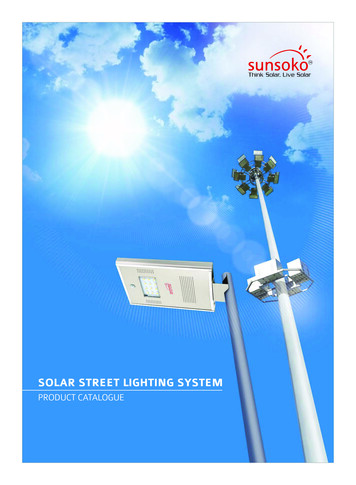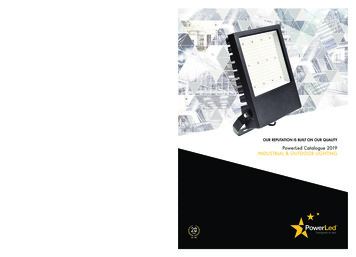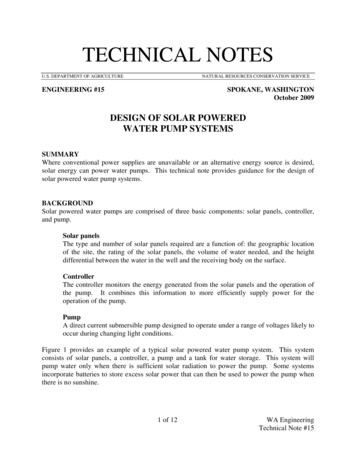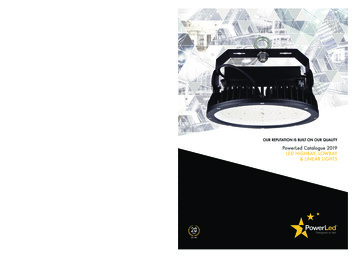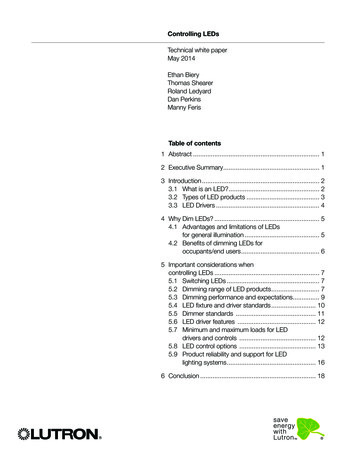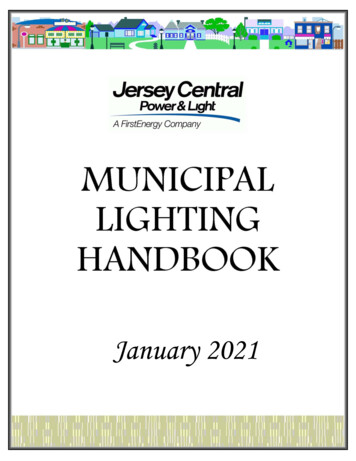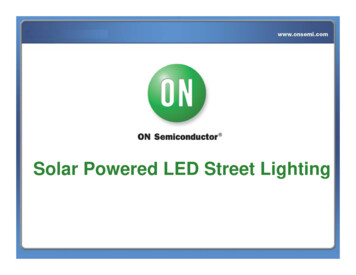
Transcription
Solar Powered LED Street Lighting
Solar Powered LED Street LightingCourtesy of BetaLightingwww.onsemi.com2
Agenda Trends for solar powered LED street lighting Regulating voltage out of a solar panel– Application overview– Maximum Peak Power Tracking (MPPT)– Reference design Driving High-Brightness LED (HB-LED)– Selecting a design approach– Reference designwww.onsemi.com3
The Application of Solar Powered LEDStreet Lighting LED lighting offers high efficiency, long operating life and low voltageoperation which ideal for solar Solar street lights were initially used in remote locations and disasterprone areas As LED efficacy and light output have improved, they are becomingmainstreamwww.onsemi.com4
LED Performance Over TimeLight Source Efficiency Trends180Best Announced WhiteLED R&D Capability160Lumens/watt140(4500-6000K)LED132-136 L/WHigh Volume WhiteLED Production120HID100Linear Fluorescent80CFL6040Incandescent2002002 2003 2004 2005 2006 2007 2008 2009 2010 2011 2012Source: Creewww.onsemi.com5
Tipping Point is Close on All the Major Apps 17535015030012525010020075150501005025002003 2004 2005 2006 2007 2008 2009 2010 2011 2012www.onsemi.com6Expected Lumens per 1W LEDNumber of 1W LEDs Needed400150 W Roadway400 W HID Met4x T5 FL TrofferLumens/1W LED
Regulating Voltage out ofa Solar Panelwww.onsemi.com7
Solar Power – Block DiagramLED 24 VSolar Panelwww.onsemi.com8350 mA 12 VChargeControllerBattery
Comparison of Different Types ofCharge Controllers BasicDesigned toprotect the batteryfrom overchargeor underchargePrevents reversecurrentwww.onsemi.com9 PWMControls theamount of currentcharging thebatteryTrickle charge MPPTOptimize thepower output fromthe cellBattery charge tooptimal capacity
Maximum Peak Power Tracking (MPPT) Solar panels in general are inefficient– 30% efficient– Most expensive component in the system Charge controllers and other electronics need to be asefficiency as possible to maximize the benefits– Typically implemented with a micro-controller MPPT compensates for the changing Voltage versusCurrent characteristic of the solar cell to increase theefficiencywww.onsemi.com10
Solar Panel CharacteristicsExtracting the maximum amount of power from the solar panel is difficultdue to the nonlinearity and variability of the Voltage-Current (V-I)characteristic.MPPT fools the panels into outputting a different voltage and currentallowing more power to go into the battery by making the solar cell thinkthe load is changing when you really are unable to change the load.www.onsemi.com11
Power and Voltage for a Solar PanelVoltage Current and Max Power of a Solar PanelAfternoon SunOutput Current (A)Output Current (A)Max power 6.1 w@15.99v30PowerPanel2010Output Current 500O utput Voltage (V)Voltage Current and Max Power of a Solar Panel inEvening Panel200.6PowerPanel0.420300.230Max power 17.3 w@15.4v0O utput V oltage (V )Max power 24.3 w@14.3v0O u tput V oltage (V )Voltage Current and Max Power of a Solar PanelNoon Sun
Solar Panel Charge Controller Solution :– Target Application :–– CS51221Solar Panel LED Street LightingSolar Panel Battery ChargerSpecification :––––––Input : 12 V – 24 VOutput: 12 V @ 2 AProtection: Adj Current Limit, Input UVLO, Input OVLOMaximum peak power tracking requiredEfficiency: Target 80%Isolation Required: YES – Prevent discharging thebatterieswww.onsemi.com13
Component/Topology Justification The topology was chosen as it can buck down to 12 V fromthe solar panel in the case of one batteryThe topology can also boost to 24 V in the case of 2 batteriesor more and can be easily changedAux rail available for remote transmission and monitoringCan accommodate panels as large as 90 WImplement maximum peak power tracking to improveefficiencyNeed to meet good efficiency, target costs and easy toimplementCS51221 offers:– Isolated and non-isolated topology– Adjustable pulse-by-pulse current limit– External voltage referencewww.onsemi.com14
CS51221 - Voltage Mode PWM ControllerValue PropositionThe CS51221 fixed frequency feed forward voltage mode PWM controller contains all of the features necessary for basic voltagemode operation. This PWM controller has been optimized for high frequency primary side control operation.Unique FeaturesBenefits 1 A sink/source gate drive High efficiency operation Up to 1MHz Fsw Optimize for size or efficiency External voltage reference Reduced component countApplication DataOthers FeaturesProgrammable Max Duty Cycle Limit Programmable Pulse By Pulse Overcurrent Protection Overvoltage Protection with Programmable Hysteresis Bidirectional Synchronization Market & ApplicationsConsumer Electronics: PoE PD, Automotive: Body electronics, Navigation, Computing: Power supply, Industrial: Power supplies, Process control, PoE PD, SolarPower Charger www.onsemi.com15Capable of being configured as Forward, Flyback or BoostOrdering & Package Information SOIC-16CS51221: -40 to 125 C Tj
Circuit and Block DiagramProgrammableOVLO, UVLO,VffAdjustableMax DutyCycle & FswMaximum PeakPower Trackingwww.onsemi.com16
Implementing MPPT With the CS51221Eliminates the need for anexpensive microcontrollerwww.onsemi.com17 MPPT isimplemented bydynamicallyadjusting thecurrent limit withthe Iset pin Once the Inputvoltage dropsthe pulse bypulse currentlimit is lowereduntil the inputvoltage returns
Peak Power TrackingCurrent and Voltage With Resistive Load and CS51221Controller will find the peakpower point and adjustdynamically to meetchanging sourcecharacteristicsInput Voltage (V)Input Power (W)2520PNL IV15PNL PWR10PNL CNTRL IVPNL CNTRL PWR5000.511.5Input Current (A)Current and Voltage With Resistive Load and CS5122117.5Controller tracks themaximum power the panelcan produce within -5% errorInput Power (W)17 5% Error16.516PNL PWRPNL CNTRL PWR15.51514.5140.80.91Input Current (A)www.onsemi.com181.1
MPPT – Dynamic Reaction to Full andPartial SunSun Returnsand CurrentLimit AdjustedInput VoltageSolarPanel inPartialShadeCurrent LimitVoltageFull Sunwww.onsemi.com19Panelin 50%ShadePanel in FullShadePanel Failsto ProvideMinimumPowerFast MovingShade and FullSun
MPPT Enables Lower System Cost 30% more chargetransferred fromthe panel to thebattery90 W Panel w/Basic Charge Controller60 W Panel w/MPPT MPPT enables a smaller size solar panel to be used 4/W for the panel x 30 W 120 system savingswww.onsemi.com20
Reference DesignDeviceApplicationCS51221Solar PanelBattery ogy12 V – 24 V12 V – 14.4 V2AFlybackCS51221CharacteristicMinTypMaxOutput Voltage12Output Current2A100kHzOscillator Frequency14.4UnitVNote: Easily scalable to larger solar panels & multiple batterieswww.onsemi.com21
Driving HB-LED for Street LightingApplicationswww.onsemi.com22
Solar Power – Block DiagramLED 24 VSolar Panelwww.onsemi.com23350 mA 12 VChargeControllerBattery
Metal Halide Source ReplacementNumber of LEDs RequiredAverage DeliveredLumens*Number ofLEDs Req’d2007**Number ofLEDs Req’d2012***70 W Metal Halide2,1001812100 W Metal Halide3,5003020150 W Metal Halide5,4504631175 W Metal Halide7,7006644Coefficient of Utilization250 W Metal Halide10,600906060%320 W Metal Halide15,20013086400 W Metal Halide16,50014194Lamp Type* From HID bulb data sheets, includes 60% typical fixture CU** Current best-in-class LED technology (Cree XLamp Q4 bin @ 6000K, 700 mA), includes 80% typical fixture CU. Assumes thermal equilibrium of LEDs (65 C Tj)*** Based on DOE projections of LED performance improvement, 80% CU. Assumes thermal equilibrium of LEDs (65 C Tj) LEDs make clear economic sense in lower wattage applications now,all MH applications in the near future Tradeoff on lifetime versus operating current should be consideredbased on ambient conditionswww.onsemi.com24
Strategy #1 for Coping with RapidChange in LED PerformanceModular Approach to MH Source ReplacementDriverCircuitGeneric LED StripFixed Number of LEDsGeneration 1Generation 2Generation 3A modular design approach can yield constant photometric output whilefacilitating ongoing cost reductions each time LED brightness is improvedwww.onsemi.com25
Strategy #2 for Coping with RapidChange in LED PerformanceLifetime Analysis - Aim Ahead of the Duck LF Distribution0.8* X X0.8* X1.2* X X1.2* XPrototyping with the highest performance LEDs currently available ismore expensive, but can yield a more competitive and longer lifeproduct over the long termwww.onsemi.com26
Strategy #3 for Coping with RapidChange in LED PerformancePlan for BOM savingsGeneration 1Generation 225% brighter LEDs can also mean 25% fewer LEDs. Needto plan flexibility in your driver design to accomplish thiswww.onsemi.com27
LED Street Light DesignWhat’s important? Type III street lighting pattern4200 initial lumens on target12 V Battery SourceReasonable optical efficiency; “single layer optics”Manage junction temperature for lifetimeWhat’s less important Uniformity (seeing spots is OK )Sizewww.onsemi.com28
LED Assumptions1.2.3.4.5.Output: 100 lm Typical at 350 mA @ Tj 25 deg CDrive current 350 mAOptical losses of 12% due to single layer, well coupled opticsMax ambient 40 deg CDriver losses 10% (90% efficiency target)Many LED Options Availablewww.onsemi.com29
Sizing the # of LEDs for the ApplicationFirst order estimate:– Number of emitters– Total wattageEmitter output 100 lm @ Tj 25.Derate for elevated Tj; assume Tj 90 deg C.At 90 deg C, emitter output is down 20% 80 lumens per emitter.Optical losses – 12% Æ 71 Lumens per emitter.4200 lumens required/71 lm per emitter 60 emittersVf 3.6 volts * .350 A 1.26 W (60 emitters x 1.26 W 76 W)Worst Case driver losses: 15% Total fixture wattage is 89 Wwww.onsemi.com30
LED Street Light Solution :–– Target Application :–– NCP3066Configured as a Boost ControllerSolar Panel LED Street LightingLED Light BarSpecification :–––––Input : 12 V batteryOutput : 350 mAProtection: Current Limit, Under Voltage Lockout (UVLO)Efficiency: Target 90%Isolation Required: NOwww.onsemi.com31
Component/Topology Justification Supports modular Constant current architectureConfigurable output LED current from 350 mA to 1 AAble to drive 5-10 LEDs in seriesCost effective system approachEasy to implement NCP3066 offers:–––––Dedicated ENABLE pin for low standby powerAverage current sense (current accuracy independent of LED Vf)0.2 V reference for small / low cost sense resistorUser adjustable peak current limit to maximize battery lifetimeNo loop compensation requiredwww.onsemi.com32
NCP3066 – Constant Current Multi-modeRegulatorValue PropositionThe NCP3066 is a switching regulator designed to deliver constant current to high power LEDs. The devicehas a very low feedback voltage of 235 mV (nominal) which is used to regulate the average current of the LEDstring.Typical Application diagram & Package infoUnique FeaturesBenefits Fsw from 52 to 250 kHz Optimize component sizeand efficiency Wide Vin from 3 to 40 V Allows use in many Multi-topologyversatile applications ENABLEpin 100uA standbyOthers Features 1.5 A peak current Ability to add external transistor to increase outputcurrent in buck mode or increase voltage in boostmode 2% accurate internal reference over temperatureMarket & ApplicationsENABLE Pin- PWM dimming- Low power standby Consumer Electronics: CRT, LCD TVs, STB, DVD, Automotive: Airbag, Body electronics, Brake systems,Infotainment, Navigation, Power supply, Peripherals (Printer,Scanner, Graphic card, ) Industrial: Power supplies, Process control, Homeenergy and control, Security systems, Computing:www.onsemi.com33Ordering info & SupportPDIP-8, SOIC-8, DFN-8NCP3066: -40 to 125 C Tj
NCP3066 as a Controller––––Boost: Higher output voltage and/or current is desiredBuck and SEPIC topologies also supportedController efficiency can be optimized for highest performanceSimple drive circuit to support external MOSFET or BipolarBoost example with100 V External N-FETFrom a 24 V Sourcewww.onsemi.com34
Boost Controller SchematicProgrammableMaximum DutyCycle LimitProgrammableCurrent LimitOpenLEDClampOptional:Ramp InjectionFor enhanced performanceWith high line and load variation Supports a variety of different applications from4-30 W Options for different MOSFETS (Gate Clamp)www.onsemi.com35
Iout vs. Vin of NCP3066 Boost Driving8 CREE XRE100.00%0.450ÅAccurate Current Regulation0.40098.00%96.00%0.35094.00%0.300Iout (A)92.00%0.25090.00%Æ Efficiency 90%0.20088.00%0.15086.00%0.10084.00%Automatic LED dimming underLow battery conditions0.05082.00%0.00080.00%678910Vin (V)www.onsemi.com3611121314
Reference Design LED Street putCurrentTopologyNCP3066LED Street Light 12 V Battery 25 V350 mABoostNCP3066CharacteristicTypMaxUnitOutput Voltage25VOutput Current350mAOscillator Frequency250kHzOutput Voltage Ripple8%www.onsemi.com37Min
Conclusion Highly efficient solutions like theCS51221 with MPPT are needed tomaximize the efficiency from solarpanels The NCP3066 provides aflexible/expandable solution for drivingLEDs from a battery source Expectations are increasing for solarpowered LED lighting to become theenvironmentally friendly outdoor lightingsolution for the 21st centurywww.onsemi.com38
Backupwww.onsemi.com39
Guangzhou, ChinaCourtesy of Multi-Cell Semiconductor Lighting Technology Co., Ltd.Hybrid Solar/Grid Powered Street Lampswww.onsemi.com40
Split, CroatiaCourtesy of SchréderWarm White Street Lampswww.onsemi.com41
For More Information View the extensive portfolio of power management products from ONSemiconductor at www.onsemi.com View reference designs, design notes, and other material supportingthe design of highly efficient power supplies atwww.onsemi.com/powersupplieswww.onsemi.com42
The Application of Solar Powered LED Street Lighting LED lighting offers high efficiency, long operating life and low voltage operation which ideal for solar Solar street lights were initially used in remote locations and disaster prone areas As LED efficacy and
